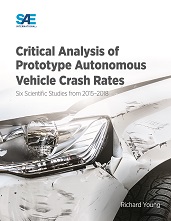Journal Article
Self-Regulation Minimizes Crash Risk from Attentional Effects of Cognitive Load during Auditory-Vocal Tasks
2014-04-01
2014-01-0448
This study reanalyzes the data from a recent experimental report from the University of Utah investigating the effect on driving performance of auditory-vocal secondary tasks (such as cell phone and passenger conversations, speech-to-text, and a complex artificial cognitive task). The current objective is to estimate the relative risk of crashes associated with such auditory-vocal tasks. Contrary to the Utah study's assumption of an increase in crash risk from the attentional effects of cognitive load, a deeper analysis of the Utah data shows that driver self-regulation provides an effective countermeasure that offsets possible increases in crash risk. For example, drivers self-regulated their following distances to compensate for the slight increases in brake response time while performing auditory-vocal tasks. This new finding is supported by naturalistic driving data showing that cell phone conversation does not increase crash risk above that of normal baseline driving.

